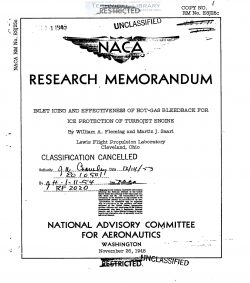naca-rm-e8j25c
- Version
- 100 Downloads
- 1.10 MB File Size
- 1 File Count
- April 21, 2017 Create Date
- April 21, 2017 Last Updated
National Advisory Committee for Aeronautics, Research Memorandum - Inlet Icing and Effectiveness of Hot Gas Bleedback for Ice Protection of Turbojet Engine

An investigation of icing and ice protection at the inlet of
a turboJet engine has been conducted in the MCA Cleveland altitude
wind tunnel. A. method of ice protection was studied whereby hot gas
was bled from the turbine inlet and injected into the air stream
ahead of the compressor inlet. Icing conditions were simulated by
spraying water into the air stream ahead of the engine nacelle.
The investigation was conducted at simulated altitudes of 5000 and
20,000 feet with ambient-air temperatures from 0° to 55° 1".
Formation of ice at the compressor inlet reduced the net thrust,
increased the specific fuel consumption based on net thrust, and
within a short period of time rendered .the engine inoperative because
of excessively high turbine temperatures. The hot-gas bleedback
system removed ice that had formed and prevented further ice forma-
tion at the compressor inlet at ambient-air temperatures from 25° to
30° F. At an ambient-air temperature of 0° 1‘, ice formation was
prevented at 11, 000 rpm, but ice formed very slowly at 10,000 rpm
with the bleedback system in operation. At an engine speed of
12,000 rpm with 4.0 percent of the gas flow bled to the inlet, the
net thrust was decreased 18.8 percent and the specific fuel consump-
tion based on net thrust was increased 21.5 percent.
Ice formation at the compressor inlet of a turboJet engine
in flight will result in a reduction in thrust. Serious icing will
render the engine inoperative as a result of excessively high
exhaust-gas temperatures. Flight in icing weather without equip-
ment to protect the engine inlet from ice is therefore extremely
hazardous, particularly with engines that have axial-flow com-
pressors.
As part of a general program being conducted at the NASA
Cleveland Laboratory on ice protection at the inlet of turbojet
engines, an investigation was conducted in the altitude wind tunnel
from April to July, 1947 with a turboJet engine having an axial-
flow compressor. A method of ice protection was studied in which
hot gas was bled from the turbine inlet and injected into the air
stream ahead of the compressor inlet in order to heat the inlet air
above the freezing temperature. This method of ice protection will
be referred to as "hot-gas bleedback". Gas was bled from the tur-
bine inlet because the gas at this station has the highest tempera-
ture and pressure in the engine.
| File | Action |
|---|---|
| naca-rm-e8j25c Inlet Icing and Effectiveness of Hot Gas Bleedback for Ice Protection of Turbojet Engine.pdf | Download |

Comment On This Post